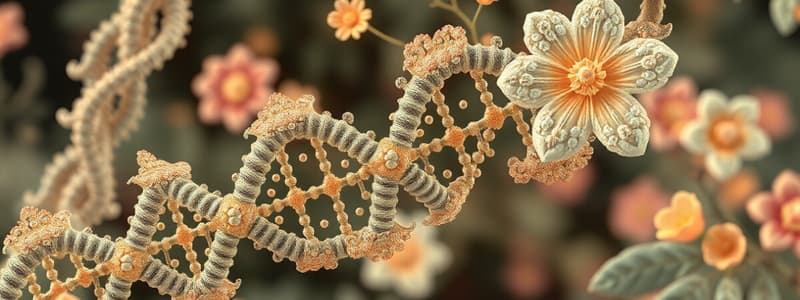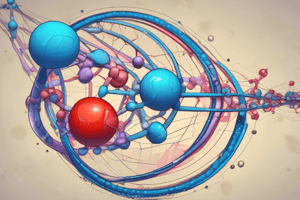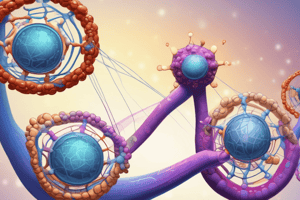Podcast
Questions and Answers
What role do chromatin writer complexes serve in relation to histones?
What role do chromatin writer complexes serve in relation to histones?
- Regulate histone modifications (correct)
- Silence gene expression
- Promote transcription of mRNA
- Repair damaged DNA strands
Which statement correctly describes histone acetylation?
Which statement correctly describes histone acetylation?
- It is carried out by chromatin erasers.
- It causes increased transcriptional silencing.
- It is mainly performed on serines.
- It tends to open up chromatin. (correct)
What is the function of small interfering RNAs (siRNAs)?
What is the function of small interfering RNAs (siRNAs)?
- To repair RNA damage
- To mimic miRNA and induce silencing (correct)
- To bind to regulatory DNA sequences
- To enhance gene transcription
What is the result of DNA methylation?
What is the result of DNA methylation?
Which type of RNA primarily regulates mRNA transcription?
Which type of RNA primarily regulates mRNA transcription?
Which feature is associated with heterochromatin?
Which feature is associated with heterochromatin?
What do mobile genetic elements, like transposons, primarily contribute to?
What do mobile genetic elements, like transposons, primarily contribute to?
What is the primary outcome of gene promoter activity?
What is the primary outcome of gene promoter activity?
What role does the XIST gene play in gene expression modulation?
What role does the XIST gene play in gene expression modulation?
How do histone modifications relate to gene expression?
How do histone modifications relate to gene expression?
What is the function of the CRISPR-Cas system in bacteria?
What is the function of the CRISPR-Cas system in bacteria?
What characterizes the plasma membrane's structure?
What characterizes the plasma membrane's structure?
What are lipid rafts known for?
What are lipid rafts known for?
How does guide RNA (gRNA) function in the CRISPR technology?
How does guide RNA (gRNA) function in the CRISPR technology?
Which of the following describes tight junctions in epithelial cells?
Which of the following describes tight junctions in epithelial cells?
What constitutes the extracellular surface of cells?
What constitutes the extracellular surface of cells?
Flashcards
Non-coding DNA
Non-coding DNA
Regions of DNA that do not code for proteins but play crucial roles in gene regulation.
Promoter
Promoter
A specific DNA sequence that initiates gene transcription. It's like the "start" button for a gene.
Enhancer regions
Enhancer regions
DNA segments that can bind regulatory proteins to enhance gene expression. They act like "boosters" for gene activity.
microRNA (miRNA)
microRNA (miRNA)
Signup and view all the flashcards
Long non-coding RNA (lncRNA)
Long non-coding RNA (lncRNA)
Signup and view all the flashcards
Chromatin writer complexes
Chromatin writer complexes
Signup and view all the flashcards
Chromatin eraser
Chromatin eraser
Signup and view all the flashcards
DNA methylation
DNA methylation
Signup and view all the flashcards
Chromatin
Chromatin
Signup and view all the flashcards
XIST RNA
XIST RNA
Signup and view all the flashcards
Histone Modifications
Histone Modifications
Signup and view all the flashcards
CRISPR/Cas System
CRISPR/Cas System
Signup and view all the flashcards
Lipid Rafts
Lipid Rafts
Signup and view all the flashcards
Tight Junctions
Tight Junctions
Signup and view all the flashcards
Glycocalyx
Glycocalyx
Signup and view all the flashcards
Intercellular Protein-Protein Interactions
Intercellular Protein-Protein Interactions
Signup and view all the flashcards
Study Notes
The Genome
- Non-coding DNA includes promoters, enhancers, regulatory RNAs, mobile genetic elements (transposons), telomeres, and centromeres
- Histones form nucleosomes, which wrap around 147 base pairs of DNA
- Heterochromatin is transcriptionally inactive, while euchromatin is active
- Histone modifications (methylation, acetylation, phosphorylation) regulate gene expression
- DNA methylation leads to transcriptional silencing
- MicroRNAs (miRNAs) regulate mRNA transcription, with each gene potentially regulating multiple exons
- MicroRNAs are processed into mature single-stranded miRNAs by "Dicer" and associate with RISC, potentially cleaving target mRNAs
- Long noncoding RNAs (lncRNAs) significantly modulate gene expression
- Gene editing utilizes CRISPR-Cas systems, repurposing a bacterial DNA-sampling system
- Guide RNAs direct Cas9 to target DNA sequences, allowing gene silencing
Cellular Housekeeping
- Plasma membranes are fluid bilayers with asymmetrical phospholipid distribution
- Lipid rafts are specialized membrane domains enriched in cholesterol and glycosphingolipids
- Extracellular surfaces are decorated with carbohydrates (glycocalyx)
- Proteins/glycoproteins facilitate transport and interactions
- Proteins can be modified post-translationally
- Passive diffusion transports nonpolar molecules across membranes
- Active transport uses energy to move molecules against concentration gradients via carriers
- Endocytosis (pinocytosis, phagocytosis) internalizes substances
- Exocytosis releases substances
- Transcytosis transports substances through cells via vesicles
- Cytoskeletal proteins (actin microfilaments, intermediate filaments, microtubules) provide structural support and facilitate movement
Endoplasmic Reticulum & Golgi Apparatus
- Rough ER has ribosomes for protein synthesis, folding, and complex formation
- Misfolded proteins are degraded
- Golgi apparatus processes and modifies proteins
- Protein modification includes addition of N-linked and O-linked oligosaccharides
- Smooth ER is abundant in cells with steroid hormone production
- Lysosomes break down cellular components
- Proteasomes degrade tagged proteins
Metabolism & Mitochondria
- Mitochondria play key roles in energy production, oxidative metabolism, and intermediate metabolism
- Mitochondrial DNA is mostly maternally inherited
- Rapidly dividing cells may exhibit the Warburg effect
- External injury can damage mitochondria, potentially triggering cell death (necrosis) or apoptosis
Cellular Activation
- Signal transduction pathways involve cell-surface receptors (ion channels, G-protein-coupled receptors, tyrosine kinases) and intracellular receptors
- Ligands bind to high-affinity receptors, initiating intracellular events
- Receptors can have intrinsic kinase activity or involve non-receptor tyrosine kinases
- Transcription factors bind to DNA to regulate gene expression
- Growth factors stimulate cell cycle entry
- Extracellular matrix provides structural support and regulates cell proliferation
Cytoskeletal Proteins
- Actin microfilaments, intermediate filaments and microtubules give cells structural support and facilitate movement within the cell
- Microtubules are used in movement, particularly of vesicles
Studying That Suits You
Use AI to generate personalized quizzes and flashcards to suit your learning preferences.




